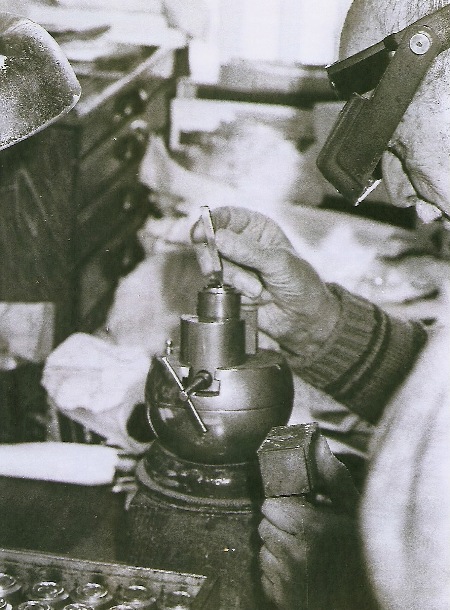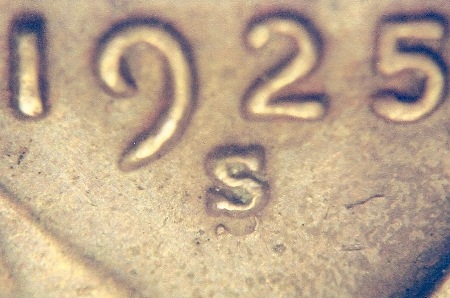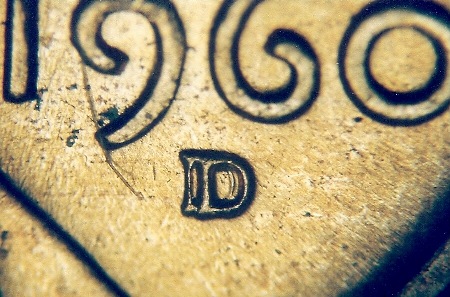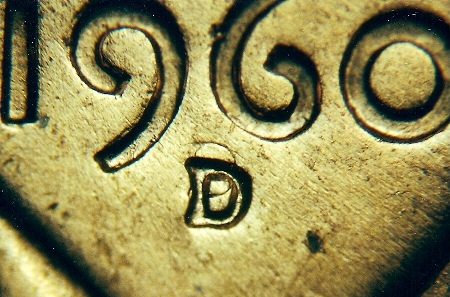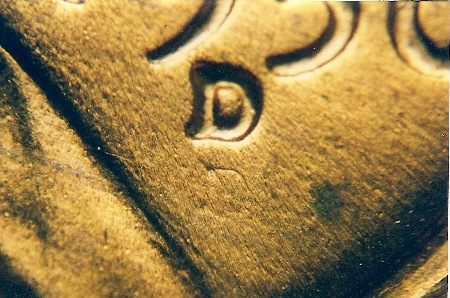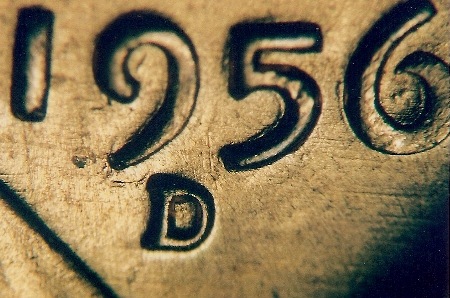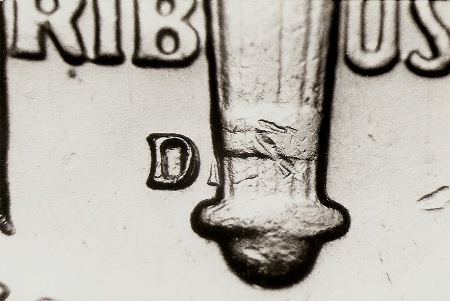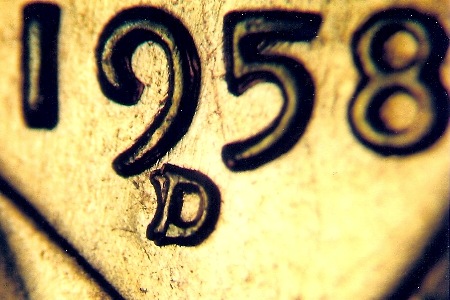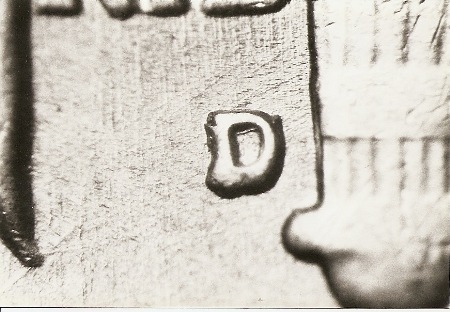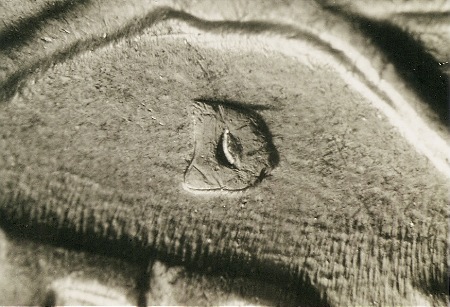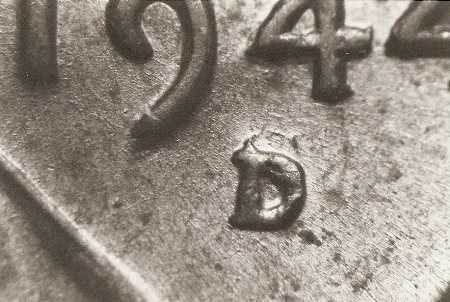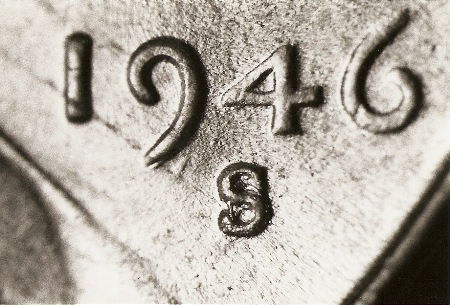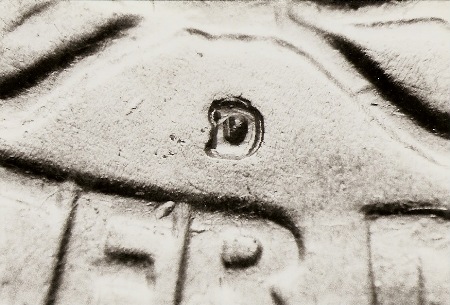


 |
 |
 |
 |
 |
 |
 |
 |
 |
 |
 |
 |
 |
 |
 |
 |
 |
 |
 |
 |
 |
 |
 |
 |
When the Mint started using mint marks (letters) in the early 1800's to identify the various branch mints at which coins were being struck, the mint mark was hand punched into the working dies that would be striking the coins. It was the last portion of the design to be placed on the die. These mint mark letters are as follows: D for Denver, S for San Francisco, C for Charlotte (gold coins only), CC for Carson City, D for Dahlonega (gold coins only), O for New Orleans, P for Philadelphia, and W for West Point. A die maker would take a thin steel rod (punch) that had the mint mark engraved on one end and hold it in place on the working die where the mint mark was to be applied. Using a mallet he tapped an impression of the mint mark into the die. In most cases it was necessary to strike the punch more than once with the mallet in order to leave a satisfactory impression of the mint mark in the die.
This photo, courtesy of Error Trends Coin Magazine (ETCM) and Arnold Margolis, shows a Mint engraver getting ready to punch a mint mark into a working die. The working die is held in a vise. His right hand is positioning the mint mark punch and the mallet that he will use to tap the mint mark punch into the die is being held in his left hand. If there was any kind of movement of the mint mark punch in between the taps of the mallet, the die would end up with a doubled, tripled, or even quadrupled mint mark. Usually, the multiple mint mark impressions would be overlapping images, but in some extreme cases the mint mark impressions would be totally separated. When the multiple mint mark impressions are from the same mint mark (a D punched over a D, or an S punched over an S), the variety is known as a Repunched Mint Mark (RPM) variety. The symbolism D/D is used to refer to a "D punched over a D." Likewise, S/S is used to refer to an "S punched over an S." If the mint mark impressions are totally separated, the symbolism D & D, read "D and D", is used since the one mint mark really is not punched over the other mint mark. Throughout our discussion we will usually refer to the D (Denver) and S (San Francisco) mint marks as they are the mint marks most familar to the collectors of modern day coinage. In describing mint mark punches a direction often accompanies the D/D or S/S symbolism such as D/D North or D/D West. When this is given, the direction refers to the direction you must travel to get from the primary (strongest) mint mark punch to the secondary (weaker) mint mark punches. Think in reverse order here. The secondary punches (weaker punches) were the first to be punched into the working die and did not penetrate as deeply in the working die. The primary punch would be the strongest punch making the deepest impression in the working die and was punched into the working die last. An RPM variety described as a D/D North would indicate that the weaker (secondary) mint mark punch is north of the stronger (primary) mint mark punch. An RPM variety described as a D/D South would have the weaker mint mark south of the stronger mint mark.
This 1925-S Lincoln cent is listed as 1925-S 1¢ WRPM-001. It features an S/S South. Notice how the weaker (secondary) mint mark is south of the stronger (primary) mint mark.
This 1960-D Lincoln cent RPM variety is listed as 1960-D 1¢ WRPM-001 and has a D/D West.
This 1960-D Lincoln cent RPM variety is listed as 1960-D 1¢ WRPM-003 and has a D/D North.
On this 1956-D Lincoln cent a totally separated mint mark can be found well south of the primary mint mark. It is listed as 1956-D 1¢ WRPM-008 and is described as a D & D South.
This 1956-D Lincoln cent has a mint mark punched well northwest of the primary mint mark. It was punched into the bottom of the 9 and is completely separated from the primary mint mark. It is listed as 1956-D 1¢ WRPM-023 and is described as a D & D Northwest.
Here we have a 1964-D Roosevelt dime that has a completely separated D mint mark punched east of the primary mint mark. The secondary mint mark is sticking out of the left side of the bottom of the torch to the right of the primary mint mark. It is listed as 1964-D 10¢ WRPM-005 and described as a D & D East. In some cases the mint mark punches are so closely overlapping that it is not possible to give a direction. Often the one punch will be "tilted" or "rotated" with respect to the other. The Wexler RPM Files refer to these as "D/D Tilted" while CONECA refers to them as "D/D Rotated." When you see these descriptions for RPM varieties it is important for you to realize that they are referring to the same type of mint mark orientations.
This 1958-D Lincoln cent is listed as 1958-D 1¢ WRPM-003. One of the mint mark punches was tilted or rotated with respect to the other. In the Wexler Files it is classified as a D/D Tilted. Over the years some RPM varieties have been found with some very unusual orientations. These would include RPM varieties where one of the mint mark punches is in a horzontal position rather than an upright position. These are referred to as "D over Horizontal D" (D/D Horizontal) mint mark varieties or "S over Horizontal S" (S/S Horizontal) mint mark varieties.
This 1961-D Lincoln cent RPM features a D punched over a horizontal D. It is listed as 1961-D 1¢ WRPM-001.
This 1962-D Roosevelt dime also features a D punched over a horizontal D. It is listed as 1962-D 10¢ WRPM-001. Another unusual orientation for some RPM varieties is when one of the mint mark impressions is from a punch that is in an "inverted" or upside-down position. References to a "D/D Inverted" or an "S/S Inverted" refer to these types of RPM varieties.
A 1958-D Jefferson nickel has a D punched over an Inverted D. It is listed as 1958-D 5¢ WRPM-003.
Here we see a 1956-D Washington quarter with a D punched over an Inverted D. It is listed as 1956-D 25¢ WRPM-001.
Over the years mint mark varieties have been found where mint marks for two different mints were applied to the same working die. For example, in 1944 two different Lincoln cent working dies first received an impression from an S mint mark punch, and then had a D mint mark punched over the S creating two different "D over S" or "D/S" mint mark varieties. In 1946 a Lincoln cent working die first received an impression of a D mint mark and then had an S mint mark punched directly over the D creating an "S over D" or "S/D" mint mark variety. Varieties such as these are known as Over Mint Mark (OMM) varieties.
Here we see a 1944-D Lincoln cent with a very nice OMM variety. It has a D punched over an S. It is listed as 1944-D 1¢ WOMM-001.
This 1946-S Lincoln cent features an OMM variety that has an S punched over a D. It is listed as 1946-S 1¢ WOMM-001.
Here we see a 1950-D Washington quarter OMM variety that has a very nice D over an S. It is listed as 1950-D 25¢ WOMM-001. There is a distinction among the die variety attributers for mint mark varieties bearing two different mint marks when those mint mark punches are totally separated. In the Wexler Files, the Crawford Files, and the Potter Files, the mint mark varieties with two different totally separated mint mark punches are listed as Dual Mint Mark (DMM) varieties since the mint mark punches are not actually "over" each other as the term "Over Mint Mark" suggests. CONECA is the only major die variety lister that does not make the distinction between OMMs and DMMs and classifies all varieties with two different mint marks as OMM varieties.
1956 was a great year for mint mark varieties. This 1956-D Lincoln cent shows an S mint mark punched between the lower 1 and 9 of the date. All of the major die variety attributers except for CONECA have listed this one as a Dual Mint Mark (DMM) variety. CONECA's attributer does not believe that the image between the lower 1 and 9 represents an S mint mark punch. You be the judge. It is listed in the Wexler Files as 1956-D 1¢ WDMM-001. The RPM and OMM varieties are two die variety types that the Mint has successfully eliminated from modern day coinage. The first changes to the procedure of applying the mint marks to coinage came in the mid-1980s when the mint mark started to appear to the original model design for commemorative coins and regular proof coins. In 1990 and 1991 the Mint began applying the mint mark for circulating coins to the master die. After 1994 the mint mark was applied directly to the original model for all U.S. coins thus ending the RPM and OMM era. RPM collecting has proven quite popular with die variety collectors as they are not that difficult to find with a little bit of searching. Collections can be assembled at a modest cost with most varieties going for a few dollars. A pretty good rule of thumb for value is that as the separation between the mint mark punches increases, the value increases. OMM varieties have always proven to be more valuable than the RPM varieties as there are far fewer of them.
If you have suspected RPMs, OMMs, or DMMs that you would like to have attributed, the following guidelines must be followed. 1. The
fee for attributions is $5 per coin. Return postage and insurance is
extra and must be included with any coins that are sent. The rule of
thumb for return postage is that whatever it costs you for postage and
insurance to send the coins to me, that’s the amount that should be
included for postage and insurance to return the coins to you. Do NOT
include any padded mailers or other mailing envelopes in your package.
All packaging supplies for the return of the coins are provided as part
of the attribution service. Payment can be made with cash, money
orders, or personal checks.
The Comprehensive Guide To Lincoln Cent Repunched Mint Mark Varieties 1909 - 1939 by John A. Wexler, Brian Allen, and John W. Bordner. This 252 page (8 ½ by 11 format) book is a complete listing of all Lincoln cent RPMs and OMMs from 1909 to 1939 listed in the Wexler Die Variety Files. It contains over 750 photos and illustrations. All known major die markers, including stage markers, are photographed. A complete shot of every RPM or OMM plus a date to mint mark relationship accompanies each listing. There are over 60 new listings for this era that have never been listed previously. The book includes descriptions, values, and cross-references to presently known listings. A totally new information section is included to aid collectors. The Comprehensive Guide to Lincoln Memorial Cent Repunched Mint Mark Varieties: 1959 by John A. Wexler and John W. Bordner. This 260 page (8 ½ by 11 format) hardbound book is the first volume in a series of RPM books issued for the Lincoln Memorial cents. It features all of the RPM varieties listed in the Wexler RPM Files for the 1959 Lincoln cents. Currently there are 111 listings for that one date alone. Those 111 listings are more than any other attributer. The pages are printed on attractive high quality 70 pound acid-free opaque paper. The book is 260 pages with nearly 1,100 photos and illustrations. Some of the features of this book include: A forward by Albert B. Raddi; Photos and descriptions of all die markers, including stage markers; Die marriage changes; Grade pricing for all RPMs; Cherrypickers’ Guide and CONECA cross-references when known; A grading guide; Die marker terms as well as navigation directions and explanations. The Authoritative Reference on Lincoln Cents - Second Edition by Kevin Flynn and John A. Wexler. This 470 page book has extensive sections on doubled dies and RPMs. The RPM chapter illustrates all of the Top 100 Lincoln cent RPM varieties as featured in The Complete Price Guide and Cross Reference to Lincoln Cent Mint Mark Varieties by Brian Allen and John A. Wexler which was published in 1999. It also illustrates all of the RPM varieties listed on the CONECA Top 100 Lincoln cent RPM list. Many other Lincoln cent RPMs that could easily be on either Top 100 list are also illustrated. Many collectors now look at this RPM chapter as the "must have" list of RPM varieties. Go To: | ||



